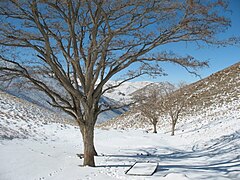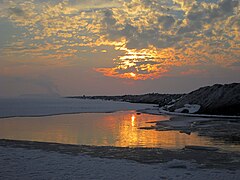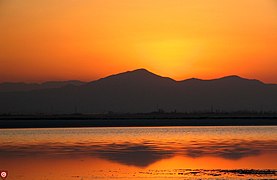
A | B | C | D | E | F | G | H | CH | I | J | K | L | M | N | O | P | Q | R | S | T | U | V | W | X | Y | Z | 0 | 1 | 2 | 3 | 4 | 5 | 6 | 7 | 8 | 9
Arak
Persian: اراک | |
|---|---|
City | |
 Clockwise from top: Bakhtyari Bridge, Valiasr Square, Senjan, City Park, and the old bazaar. | |
| Coordinates: 34°05′29″N 49°41′36″E / 34.09139°N 49.69333°E[1] | |
| Country | Iran |
| Province | Markazi |
| County | Arak |
| District | Central |
| Established | 1808 |
| Government | |
| • Mayor | Alireza Mahmoudi[2] |
| Elevation | 1,718 m (5,636 ft) |
| Population (2016)[3] | |
| • Total | 520,944 |
| Time zone | UTC+3:30 (IRST) |
| Area code | 086 |
| Climate | Dsa |
| Website | arak |
Arak (Persian: اراک; IPA: [æˈɾɒːk] )[a] is a city in the Central District of Arak County, Markazi province, Iran, serving as capital of the province, the county, and the district.[5]
At the 2006 National Census, its population was 438,338 in 121,597 households.[6] The following census in 2011 counted 484,212 people in 148,249 households.[7] The 2016 census showed a population of 520,944 people in 165,709 households.[3]
The city is nicknamed the "Industrial Capital of Iran".[8][9] As a major industrial city, Arak hosts several industrial factories inside and within a few kilometers outside the city, including the factory of Machine Sazi Arak and the Iranian Aluminium Company. These factories produce nearly half of the needs of the country in steel, petrochemical, and locomotive industries.
Etymology
Arâk
The term Arâk remains from a name given to the region since the medieval period. It derives from Arabic al-ʿIrāq, meaning "root",[10] itself derived possibly from Akkadian Uruk (Hebrew: אֶרֶךְ, Erech). But new research has shown that the word Arak has the same roots with the words Iran and Arran, and the name Iraq is an Arabicized Persian word.[11]
During the Seljuk era, a region comprising the whole territory of Media (northwestern Iran) and the lower part of Mesopotamia was referred to as Iraq; with the Median part called ʿErâq-e ʿAjam ("Iraq of the Ajam "), and the Mesopotamian part called ʿErâq-e ʿArab ("Iraq of the Arab").[12]
Soltân Âbâd
The term Soltân Âbâd is a Persian compound word.
Soltân, deriving from Arabic sulṭān ("power", "authority"), is a Near Eastern noble title given to a powerful governor. Modern Persian âbâd, meaning "settlement" or "abode", derives from Middle Persian āpāt ("populous"). However, according to linguist Sasha Lubotsky, the Persian term ābād might derive from Proto-Iranian *āpāta ("protected"), rooting from Proto-Indo-European *peh₂- ("to protect").
History

Originally named Soltan Abad, the modern-day city of Arak was founded in 1808 by Yusef Khan-e Gorji,[14] a pro-Iranian warlord of Georgian Muslim origin who was given refuge by Qajar ruler Agha Mohammad Khan following a territorial dispute with his cousins, who were supported by Russian empress Catherine the Great.
Between 1795 and 1797, Yusef Khan-e Gorji, renamed Yusef Khan-e Sepahdar by the Qajar ruler, settled his army in the fertile but poorly-controlled territory that would become the modern-day Arak. Hostile tribes in the region had operated autonomously from the Qajar rule. With the Shah's approval, Yusef Khan diverted the main river to drive out the hostiles and build the war fortress of Soltan Abad to act as a buffer.
According to early modern historians, Yusef Khan built the city with the aid of effluents. Until 1892, the town remained a military base and fortress. The fortress of Soltan Abad had a thick wall surrounded by 7-meter-deep moats. Eight towers were constructed around the town and the governmental building was established in its northern part.[citation needed]
In 1891, shops, gardens, and government buildings of Soltan Abad were repaired by the order of deputy governor Mirza Hasan (Etemad os-Saltane). Large parts of the city were formerly annexed as personal property to the pre-existing army commanders, and were then ultimately turned over to the state around 1918–1922.
Beginning by the last quarter of the 19th century, the city achieved major developments in carpet industry, and eventually became Iran's most important center of carpet production for export markets, continuing up until at least 1940.[15]

Under the reign of Reza Shah of the Pahlavi dynasty, the city was renamed Arak. Modern factories for vegetable oil, soap, sugar beet, and wool industries were established within the city. Arak also became an important station for the Trans-Iranian Railway, a major railway project directed by Reza Shah which was completed in 1938.[citation needed]
In 1972, two major state-owned enterprises were established in the city, including an aluminum smelter and a heavy engineering plant. The aluminum smelter was built under the Regional Cooperation for Development project of the Central Treaty Organization, in cooperation with the company of Reynolds and Reynolds. The engineering plant was processed with equipment and technical advice from the Soviets, in return of gas sales to the Soviet Union.[citation needed]
The city officially became a metropolis on April 6, 2013, after the merger with Karahrud and Senjan.[16][17]
Geography
Arak is surrounded by mountains in the south, west, and east, and its average altitude is about 1750m above sea level. It is located 260 km from the city of Tehran, and is in the vicinity of the cities of Qom and Isfahan.
-
The Gerdoo Valley in winter.
-
Sefidkhani Mountain, located to the west of Arak.
-
Meyqan Lagoon, 15 km northeast of Arak.
-
Sunset in Meyqan Lagoon.
Climate
Arak has a hot-summer mediterranean continental climate (Köppen: Dsa, Trewartha: Dc), that is, in general, relatively cold and dry.
The weather of the city is hot and dry in summer, cool in autumn, cold and snowy in winter, and mild in spring. Its maximum temperature may rise to above 35 °C or 95 °F in summer and fall to below −25 °C or −13 °F in winter. The average annual precipitation is around 337 millimetres or 13.3 inches and the annual relative humidity is about 47%.
| Climate data for Arak (1991-2020, extremes 1961-2020) | |||||||||||||
|---|---|---|---|---|---|---|---|---|---|---|---|---|---|
| Month | Jan | Feb | Mar | Apr | May | Jun | Jul | Aug | Sep | Oct | Nov | Dec | Year |
| Record high °C (°F) | 18.2 (64.8) |
23.6 (74.5) |
27.8 (82.0) |
31.0 (87.8) |
35.4 (95.7) |
41.0 (105.8) |
44.0 (111.2) |
41.0 (105.8) |
38.0 (100.4) |
31.2 (88.2) |
25.0 (77.0) |
22.0 (71.6) |
44.0 (111.2) |
| Mean daily maximum °C (°F) | 5.2 (41.4) |
8.8 (47.8) |
14.4 (57.9) |
19.9 (67.8) |
25.8 (78.4) |
32.5 (90.5) |
35.7 (96.3) |
34.9 (94.8) |
30.7 (87.3) |
23.4 (74.1) |
14.0 (57.2) |
8.3 (46.9) |
21.1 (70.0) |
| Daily mean °C (°F) | −0.3 (31.5) |
2.8 (37.0) |
8.0 (46.4) |
13.4 (56.1) |
18.7 (65.7) |
25.0 (77.0) |
28.1 (82.6) |
26.9 (80.4) |
22.2 (72.0) |
15.5 (59.9) |
7.5 (45.5) |
2.6 (36.7) |
14.2 (57.6) |
| Mean daily minimum °C (°F) | −5.0 (23.0) |
−2.5 (27.5) |
2.0 (35.6) |
7.0 (44.6) |
11.3 (52.3) |
16.2 (61.2) |
19.8 (67.6) |
18.5 (65.3) |
13.5 (56.3) |
8.1 (46.6) |
2.0 (35.6) |
−2.0 (28.4) |
7.4 (45.3) |
| Record low °C (°F) | −29.6 (−21.3) |
−30.5 (−22.9) |
−22 (−8) |
−7.0 (19.4) |
0.0 (32.0) |
4.0 (39.2) |
12.0 (53.6) |
10.0 (50.0) |
2.0 (35.6) |
−4.0 (24.8) |
−17 (1) |
−23 (−9) |
−30.5 (−22.9) |
| Average precipitation mm (inches) | 36.0 (1.42) |
35.5 (1.40) |
57.3 (2.26) |
55.2 (2.17) |
26.9 (1.06) |
3.6 (0.14) |
1.4 (0.06) |
1.7 (0.07) |
1.1 (0.04) |
17.5 (0.69) |
39.1 (1.54) |
40.2 (1.58) |
315.5 (12.43) |
| Average precipitation days (≥ 1.0 mm) | 5.8 | 5 | 6.6 | 6.8 | 4.6 | 0.7 | 0.5 | 0.4 | 0.2 | 2.7 | 5.1 | 5.5 | 43.9 |
| Average snowy days | 7 | 5.6 | 2.7 | 0.3 | 0 | 0 | 0 | 0 | 0 | 0 | 0.6 | 4.5 | 20.7 |
| Average relative humidity (%) | 70 | 62 | 51 | 48 | 40 | 27 | 25 | 24 | 27 | 41 | 60 | 69 | 45 |
| Average dew point °C (°F) | −5.9 (21.4) |
−4.8 (23.4) |
−3.1 (26.4) |
1.1 (34.0) |
3.1 (37.6) |
2.7 (36.9) |
4.5 (40.1) |
3.4 (38.1) |
0.7 (33.3) |
0.4 (32.7) |
−0.9 (30.4) |
−3.4 (25.9) |
−0.2 (31.7) |
| Mean monthly sunshine hours | 159 | 182 | 217 | 230 | 287 | 338 | 327 | 334 | 304 | 256 | 177 | 153 | 2,964 |
| Source: NOAA NCEI[18] (snow days 1981-2010)[19] (1961-1990 extremes)[20] | |||||||||||||
| Climate data for Arak | |||||||||||||
|---|---|---|---|---|---|---|---|---|---|---|---|---|---|
| Month | Jan | Feb | Mar | Apr | May | Jun | Jul | Aug | Sep | Oct | Nov | Dec | Year |
| Record high °C (°F) | 17.0 (62.6) |
21.0 (69.8) |
25.2 (77.4) |
29.0 (84.2) |
35.0 (95.0) |
41.0 (105.8) |
44.0 (111.2) |
41.0 (105.8) |
38.0 (100.4) |
31.0 (87.8) |
24.0 (75.2) |
20.0 (68.0) |
44.0 (111.2) |
| Mean daily maximum °C (°F) | 4.2 (39.6) |
7.3 (45.1) |
13.7 (56.7) |
19.7 (67.5) |
25.6 (78.1) |
32.5 (90.5) |
35.7 (96.3) |
34.9 (94.8) |
30.7 (87.3) |
23.2 (73.8) |
14.5 (58.1) |
7.7 (45.9) |
20.8 (69.5) |
| Daily mean °C (°F) | −0.8 (30.6) |
1.9 (35.4) |
7.8 (46.0) |
13.4 (56.1) |
18.2 (64.8) |
24.0 (75.2) |
27.3 (81.1) |
26.4 (79.5) |
21.9 (71.4) |
15.6 (60.1) |
8.4 (47.1) |
2.8 (37.0) |
13.9 (57.0) |
| Mean daily minimum °C (°F) | −5.7 (21.7) |
−3.4 (25.9) |
2.0 (35.6) |
7.0 (44.6) |
10.9 (51.6) |
15.5 (59.9) |
19.0 (66.2) |
17.9 (64.2) |
13.1 (55.6) |
7.9 (46.2) |
2.4 (36.3) |
−2.1 (28.2) |
7.0 (44.7) |
| Record low °C (°F) | −29.6 (−21.3) |
−30.5 (−22.9) |
−22 (−8) |
−7.0 (19.4) |
0.0 (32.0) |
4.0 (39.2) |
12.0 (53.6) |
10.0 (50.0) |
2.0 (35.6) |
−4.0 (24.8) |
−17 (1) |
−23 (−9) |
−30.5 (−22.9) |
| Average precipitation mm (inches) | 51.6 (2.03) |
43.3 (1.70) |
57.1 (2.25) |
53.6 (2.11) |
30.0 (1.18) |
2.8 (0.11) |
1.2 (0.05) |
1.6 (0.06) |
0.9 (0.04) |
16.9 (0.67) |
33.7 (1.33) |
44.4 (1.75) |
337.1 (13.28) |






